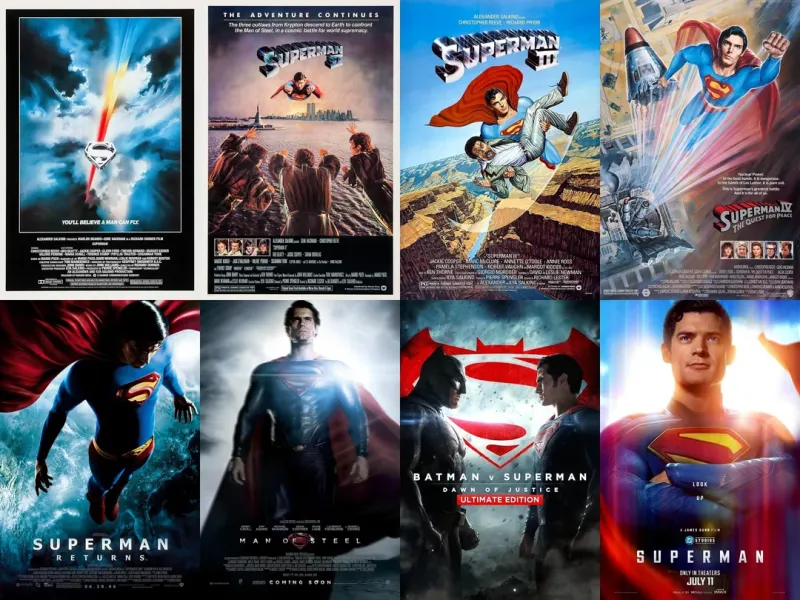
With the newest Superman film still in theaters and being debated by fans, it seemed appropriate to take a moment and look at how this iconic character got its roots.
The Birth of Superman
Superman, the quintessential superhero, was created by writer Jerry Siegel and artist Joe Shuster, two young men from Cleveland, Ohio, who dreamed up the character in the early 1930s.
Inspired by pulp fiction, mythology, and their own experiences as children of Jewish immigrants, Siegel and Shuster envisioned a powerful figure who could protect the vulnerable and embody hope. Their creation, initially conceived as a villain in a 1933 short story titled "The Reign of the Superman," evolved into the heroic icon we know today.
In 1938, Superman debuted in Action Comics #1, published by National Allied Publications (later DC Comics). The cover, featuring Superman lifting a car above his head, became iconic. The character, a super-powered alien from the planet Krypton named Kal-El, disguised as mild-mannered reporter Clark Kent, struck a chord with readers during the Great Depression.
Siegel and Shuster’s Superman fought for truth, justice, and the underdog, battling corrupt politicians, gangsters, and societal wrongs. However, the creators sold the rights to Superman for just $130, a decision that led to years of financial struggles for both men, despite their creation’s immense success.
The Evolution of Superman Comics
Superman’s comic book journey spans over eight decades, evolving with cultural shifts and reader expectations.
In the Golden Age (1938–1950s), Superman’s stories in Action Comics and his self-titled series were straightforward, focusing on his superhuman feats and moral clarity. His powers grew over time, from leaping tall buildings to flying and gaining abilities like X-ray vision and super-hearing. The introduction of key elements like Lois Lane, Lex Luthor, and kryptonite shaped the mythos.
The Silver Age (1950s–1970s) brought wilder, more imaginative stories. Superman’s adventures often leaned into science fiction, with bizarre plots involving time travel, alternate dimensions, and characters like Bizarro and Mr. Mxyzptlk. The comics also introduced the Fortress of Solitude and expanded Krypton’s lore. However, the stories remained lighthearted, reflecting post-war optimism.
The Bronze Age (1970s–1980s) grounded Superman slightly, with a focus on character development and social issues. Writers like Dennis O’Neil and artists like Neal Adams explored Clark Kent’s humanity and tackled topics like pollution and racism. The 1986 reboot, The Man of Steel by John Byrne, modernized Superman, scaling back his powers and emphasizing his Kryptonian heritage versus his human upbringing.
In the modern era (1990s–present), Superman’s comics have balanced legacy with reinvention. Storylines like The Death of Superman (1992) captivated readers, showing Superman’s sacrifice against Doomsday and his eventual return. Recent runs have explored his role as a husband to Lois Lane and father to Jon Kent, reflecting contemporary themes of family and responsibility. Superman remains a symbol of hope, even as writers experiment with his vulnerabilities and moral dilemmas.
Superman on the Big Screen
Superman’s cinematic journey began with animated shorts in the 1940s by Fleischer Studios, but his first major live-action appearance was in the 1951 film Superman and the Mole Men, starring George Reeves, who also played the hero in the 1950s TV series Adventures of Superman. Reeves’ portrayal, blending strength with earnestness, cemented Superman as a cultural icon.
The 1978 film Superman: The Movie, directed by Richard Donner, was a landmark. Christopher Reeve’s portrayal of Superman and Clark Kent became definitive, capturing the character’s nobility and humanity. The film’s tagline, “You’ll believe a man can fly,” reflected its groundbreaking special effects. Reeve starred in three sequels (Superman II through IV, 1980–1987), though diminishing budgets and creative missteps lessened their impact.
After a long hiatus, Superman Returns (2006) saw Brandon Routh as Superman, continuing Reeve’s legacy in a film that blended nostalgia with modern sensibilities. Critics praised Routh’s performance, but the film’s slow pace divided audiences.
The DC Extended Universe (DCEU) introduced Henry Cavill as Superman in Man of Steel (2013), directed by Zack Snyder. Cavill’s grittier, more introspective Superman appeared in Batman v Superman: Dawn of Justice (2016) and Justice League (2017). While polarizing for its darker tone, Cavill’s portrayal resonated with fans seeking a modernized hero. He briefly returned in Black Adam (2022), but plans for a new DCEU Superman film were later scrapped.
In 2025, a new Superman film, directed by James Gunn, features David Corenswet as the Man of Steel. Released this July, it aims to balance Superman’s optimism with contemporary storytelling, marking a fresh chapter for the character. Tell us in the comments what you think about the most recent film version of Superman's story.
Beyond Comics and Film
Superman’s influence extends far beyond comics and movies. He has starred in radio serials, TV shows like Lois & Clark (1993–1997) with Dean Cain and Smallville (2001–2011) with Tom Welling, and animated series like Superman: The Animated Series (1996–2000). Video games, novels, and merchandise have further embedded him in global culture. Superman’s symbol, the red-and-blue “S” shield, is instantly recognizable, representing hope and heroism worldwide.
From Siegel and Shuster’s humble creation to a multimedia icon, Superman has endured by adapting to each era’s values while staying true to his core: a hero who inspires us to be better. As he continues to evolve, Superman remains a beacon of hope, proving that even in a complex world, truth and justice still matter.





